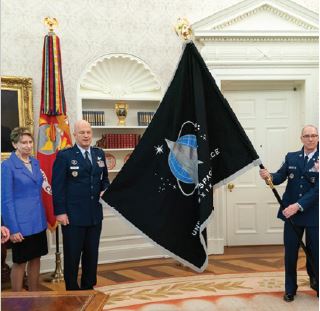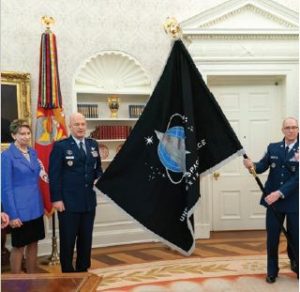Space Force: Mission Moves Forward as New Branch Begins Second Year
 U.S. Space Command commander Gen. John W. “Jay” Raymond and Senior Enlisted Advisor Chief Master Sgt. Roger Towberman presents the Space Force flag in the Oval Office of the White House, May 15, 2020. Credit: Space Force
U.S. Space Command commander Gen. John W. “Jay” Raymond and Senior Enlisted Advisor Chief Master Sgt. Roger Towberman presents the Space Force flag in the Oval Office of the White House, May 15, 2020. Credit: Space Force Introduction | The U.S. Space Force (USSF) has marked its first anniversary and secured a public affirmation from President Biden’s administration that the nation’s newest military branch will endure, allowing Space Force leadership to confidently move forward with their mission.

U.S. Space Command commander Gen. John W. “Jay” Raymond and Senior Enlisted Advisor Chief Master Sgt. Roger Towberman presents the Space Force flag in the Oval Office of the White House, May 15, 2020. Credit: Space Force
Established in 2019 under President Donald Trump, Space Force was enacted under legislation that had bipartisan support. It was viewed skeptically by some, or as unnecessary, whether from Washington insiders advocating for less bureaucracy or a general public with little understanding of increased space activity and concerns over militarization of space.1
By its first anniversary, Dec. 20, 2020, Space Force accomplished rapid growth and a string of firsts, but those achievements were overshadowed by ongoing public relations issues,2 the prospect of a new commander-in-chief, a new acting secretary of the Air Force, and congressional inquiries about a delayed mandated report on space acquisition reforms.3
Why Space Force Matters
As of Feb. 1, 2021, nearly 90 nations and 6,589 payloads operate in space, and there is increasing recognition of economic opportunity beyond Earth’s atmosphere, which invites competition for assets. China, Russia, and India have conducted anti-satellite tests, and the global economy and daily life on Earth could be severely disrupted if satellite-based services ceased. Referring to China and Russia, Gen. John Hyten, vice chairman of the Joint Chiefs of Staff, in January 2021 told the National Security Space Association of the two countries: “They’re building capabilities to use space against us. We have to be able to respond to that.”4
During the ceremony officially standing up USSF, Chairman of the Joint Chiefs of Staff, Army Gen. Mark A. Milley, described the basis for the new branch: “In military operations, space is not just a place from which we support combat operations in other domains, but [has become] a warfighting domain in and of itself. Our adversaries are building and deploying capabilities to threaten us, so we can no longer take space for granted. The U.S. Space Force is the necessary and essential step our nation will take to defend our national interests in space today and into the future.”
First Year Highlights
- Chief of Space Operations becomes the eighth member of Joint Chiefs of Staff
- Activation of Space Operations Command and Space Training and Readiness Delta (Provisional)
- Commissioning of first officers from Air Force Academy and Officer Training School directly into USSF
- Initiation of partnerships between USSF and U.S. allied nations and industries
- One-year operational anniversary of the video-based Space Cockpit5
- Start of joint USSF and NOAA Operations of Infrared Weather Satellite
- First renaming of Air Force bases and stations to Space Force: Cape Canaveral Space Force Station, Patrick Space Force Base
- Raymond calls for all defense department launches be autonomous by 2025
- Finalization and announcement that USSF space professionals will be known as guardians
- Creation of a new National Space Intelligence Center to serve as service intelligence center for Space Force
- First member of USSF in space (Col. Michael S. Hopkins transferred from USAF to USSF after arriving at International Space Station)
- First member of USSF to deploy overseas (part of a Marine Expeditionary Unit)
- First launch of an X-37B Orbital Test Vehicle under joint auspices of USSF and the Air Force Space Rapid Capability Office
- The formation of SpaceWERX, a new entity that will focus on technologies for the Space Force
- Publication of Space Force doctrine and planning guidance
Recently, Space Force officials disclosed they are fleshing out details of a unique approach to military service that combines active-duty and reserve commitments, hoping that design will provide more flexibility for families and ultimately keep people in uniform longer. “The service may decide to keep a separate Space National Guard as well”, Lt. Gen. Nina M. Armagno, staff director at Space Force headquarters, said during a Feb. 10 Space Foundation Space Symposium 365 webinar.
“We’re actually working on a dual componency, where instead of having Active, Guard, and Reserve, we have a combined Active and Reserve force, and then potentially a separate Space Guard,” she said.
Space Force FY2021
To read the full article, subscribe to The Space Report here.
1 Can Biden Solve the Space Force’s Public Relations Crisis? Defense News. Jan. 13, 2021. https://www.defensenews.com/space/2021/01/13/can-biden-solve-the-space-forces-public-relations-crisis. Accessed Jan. 29, 2021.
2 Can Biden Solve the Space Force’s Public Relations Crisis? Defense News.
3 U.S. Space Force Acquisitions to Get Fresh Look, Lawmaker Wants Hearings. SpaceNews.com. https://spacenews.com/u-s-space-force-acquisitions-to-get-fresh-look-lawmaker-wants-hearings. Accessed Jan. 27, 2021.
4 Biden Seen Likely to Keep Space Force, a Trump Favorite. APNews.com. Jan. 28, 2021. https://apnews.com/article/joe-biden-space-force-edcb01683ab38e740ae87530c49ecd4e. Accessed Jan. 28, 2021.
5 Space Cockpit a New Way to Visualize Space Operations. Dec. 3, 2020. https://www.spaceforce.mil/News/Article/2434500/space-cockpit-a-new-way-to-visualize-space-operations. Accessed Dec. 3, 2020.